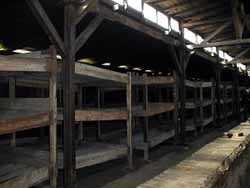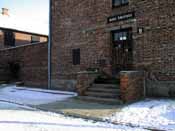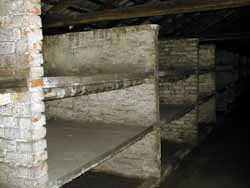Auschwitz-Birkenau: Living Conditions, Labor & Executions
Living Conditions
The reasons for the epidemics and contagious diseases that prevailed in Auschwitz concentration camp included the dreadful living conditions, which varied during the years that the camp operated, and were different in each part of the camp. In Auschwitz I, prisoners lived in old brick barracks. Several hundred three-tier wooden bunk beds were installed in each building. The overcrowding in Auschwitz I forced basements and lofts into use as living quarters, as well.
Two types of barracks, brick and wooden, housed prisoners in Birkenau concentration camp. The brick buildings were erected in great haste, without suitable insulation, on marshy ground. More than 700 people were assigned to each barrack, although in practice the figure was sometimes higher. These barracks lacked any true heating; nor did they contain sanitary facilities.
The second type of accommodation for prisoners at Birkenau consisted of wooden stable-barracks (Pferdestallbaracken). The interiors, designed to hold 52 horses, were partitioned into stalls. The stalls contained three-tier wooden bunks. Several hundred prisoners lived in each such barrack.
 |
Dampness, leaky roofs, and the fouling of straw and straw mattresses by prisoners suffering from diarrhea made difficult living conditions worse. The barracks swarmed with various sorts of vermin and rats. A constant shortage of water for washing, and the lack of suitable sanitary facilities, aggravated the situation.
Living and sanitary conditions in Auschwitz III (Monowitz) concentration camp and the several dozen branch camps resembled those described above.
Currency
One Auschwitz survivor described the cigarette currency used in the camp: “We had our own currency, whose value no one questioned: the cigarette. The price of every article was stated in cigarettes ... in ‘normal’ times, that is, when the candidates to the gas chambers were coming in at a regular pace, a loaf of bread cost 12 cigarettes; a 10 ounce package of margarine, thirty; a watch, eighty to 200; a 0.25-gallon bottle of alcohol, 400 cigarettes!”
Feeding the Prisoners
Prisoners in the camp received meals three times a day: morning, noon, and evening. Factors influencing the nutritional value of the food included the official nutritional norms in the Nazi concentration camps. In practice, Auschwitz prisoners with less physically demanding labor assignments received approximately 1,300 calories per day, while those engaged in hard labor received approximately 1,700. After several weeks on such starvation rations in the camp, most prisoners began to experience organic deterioration that led to the so-called "Muzulman" state, extreme physical exhaustion that ended in death.
Order of the Day
At Auschwitz, as in other concentration camps, the order of the day was strictly established. Prisoners spent over ten hours per day working, and the rest of the time was taken up by long roll-call assemblies, lining up for food rations or a place in the latrines or the washroom, removing dirt and pests from clothing, and disinfection.
Labor
A WVHA decree of March 31, 1942 established a minimum working day of eleven hours in all concentration camps. At Auschwitz, labor was one of the means used to destroy prisoners. They labored in various sectors of the economy. Initially, they worked at building the camp: leveling the ground, erecting new blocks and buildings, laying roads, and digging drainage ditches. Later, the industries of the Third Reich made increasing use of cheap prisoner labor. The pace of the work, the starvation rations of food, and constant beatings and abuse exacerbated the death rate. The German IG Farbenindustrie cartel, which built the Buna-Werke synthetic rubber and fuel factory at Monowice near Oswiecim, had priority in obtaining prisoner labor. The majority of the Auschwitz sub-camps were located near the mills, mines, and factories of Silesia. Prisoners dug coal, produced armaments and chemicals, and built and expanded industrial plants.
Executions
 |
Executions were one means of physically liquidating prisoners and people brought from outside the camp. At first, people were shot to death in the pits near the camp from which gravel had been dug. From the autumn of 1941 until the autumn of 1943, most of the executions by shooting took place in the courtyard of Block No. 11 in the main camp. Most of the victims here were Poles, who received sentences of death by shooting from, for instance, the Gestapo summary court.
Soviet prisoners of war were also executed at Auschwitz concentration camp. Beginning in September 1941, executions were also carried out using poison gas.
At least 2,000 Soviet prisoners of war were put to death in this way. After the dismantling of the Death Wall in 1944, larger groups of Poles sentenced to death by the police summary court were executed in the gas chambers. Executions by hanging were carried out sporadically in the camp. As opposed to shooting or killing in the gas chamber, hanging was public. It was carried out in front of other prisoners, usually during roll call. The goal was to intimidate the witnesses, and the victims were most frequently prisoners caught trying to escape, or suspected of aiding escapers.
Sources: The State Museum of Auschwitz-Birkenau. Reprinted with permission;
Yuval Noah Harari, Sapiens: A Brief History of Humankind, (NY: Harper Perennial, 2018).



